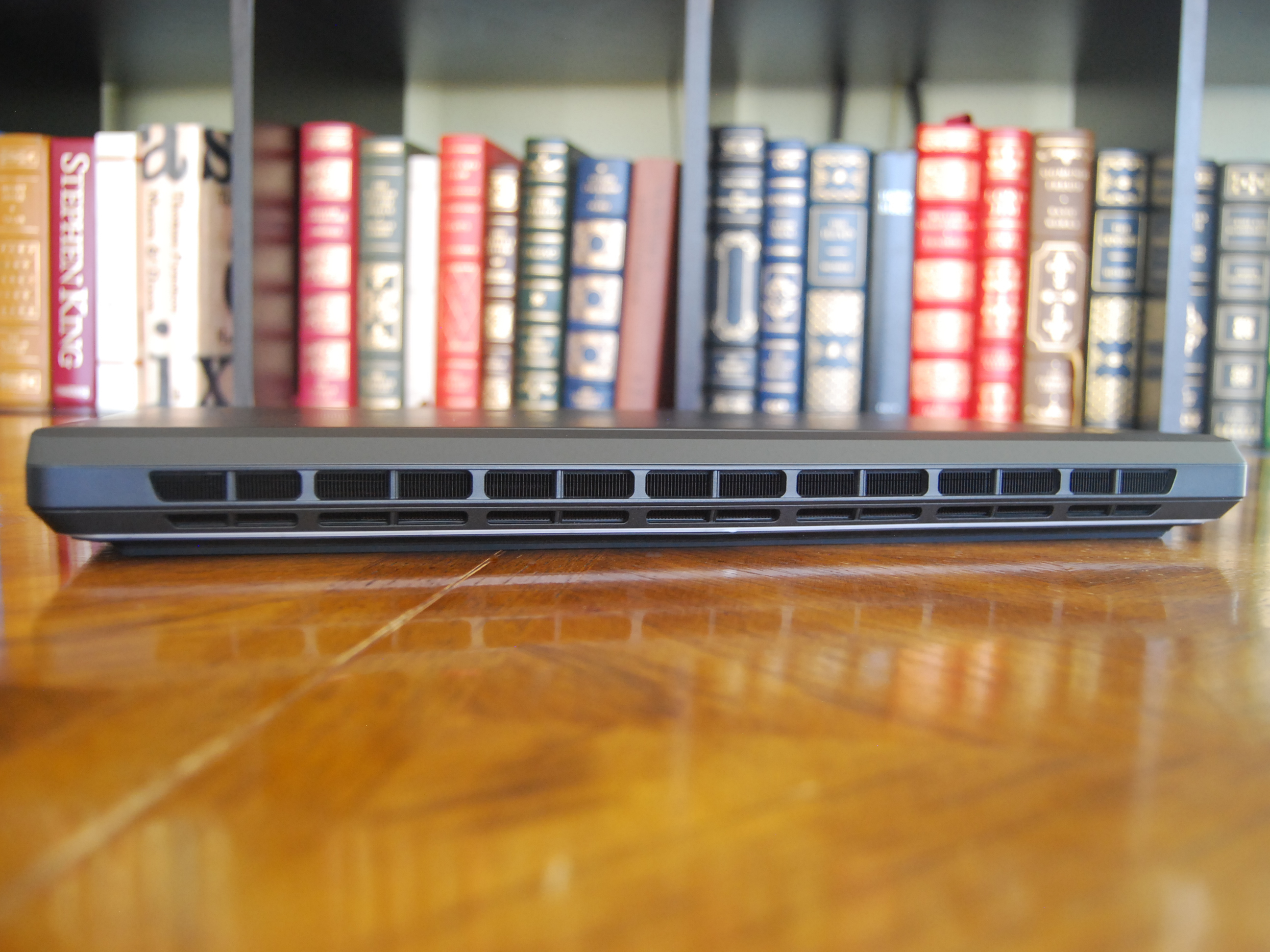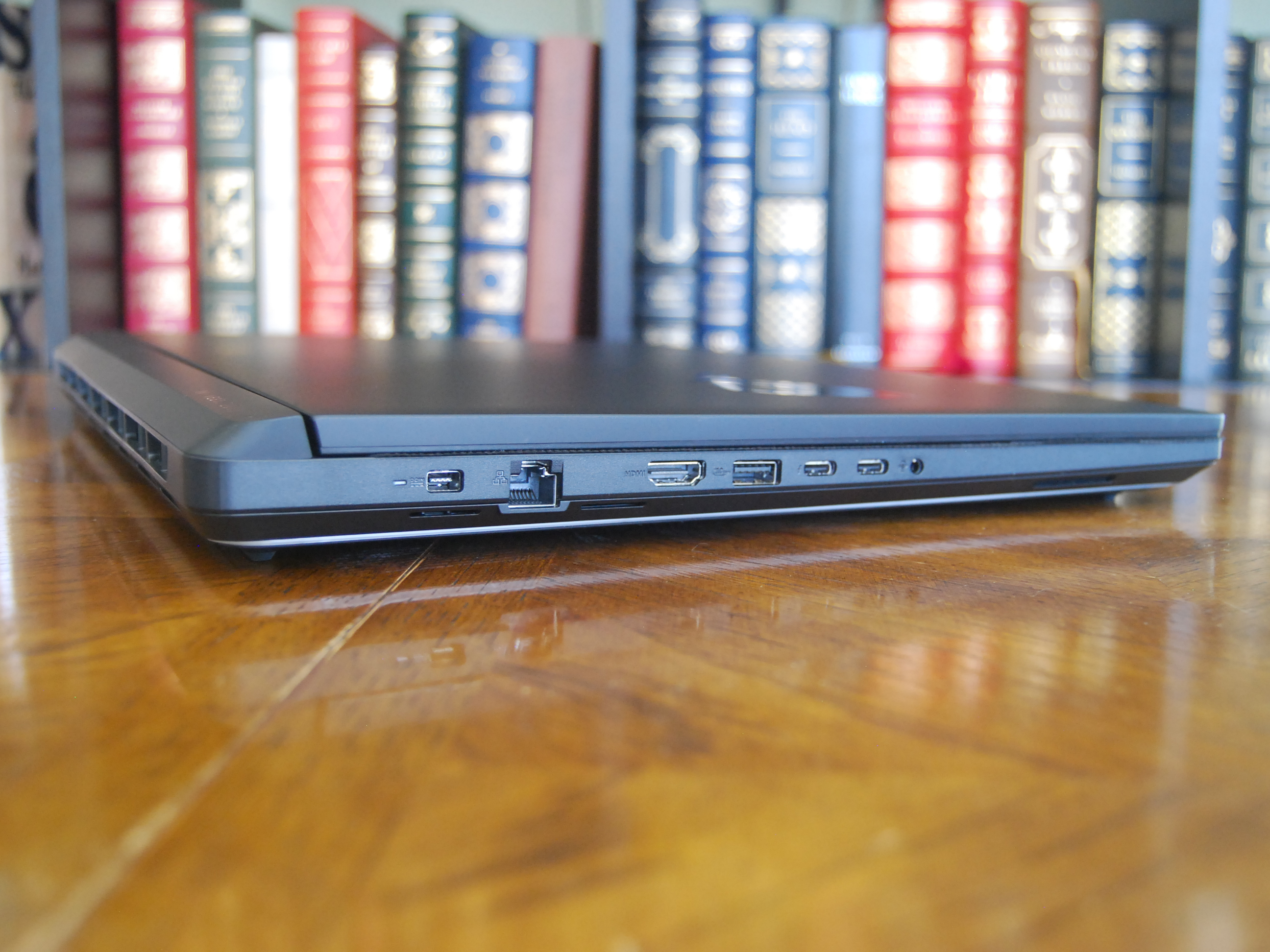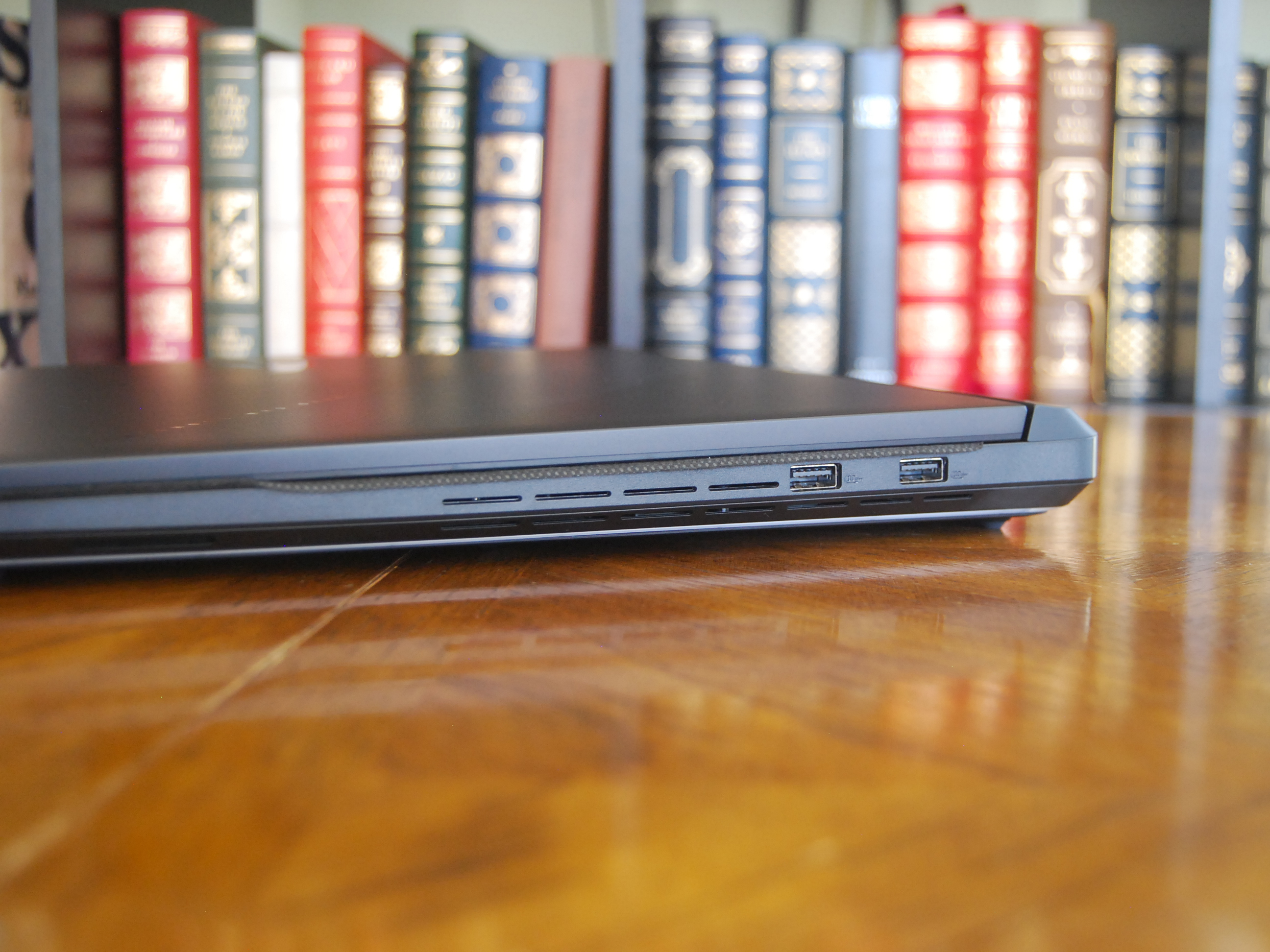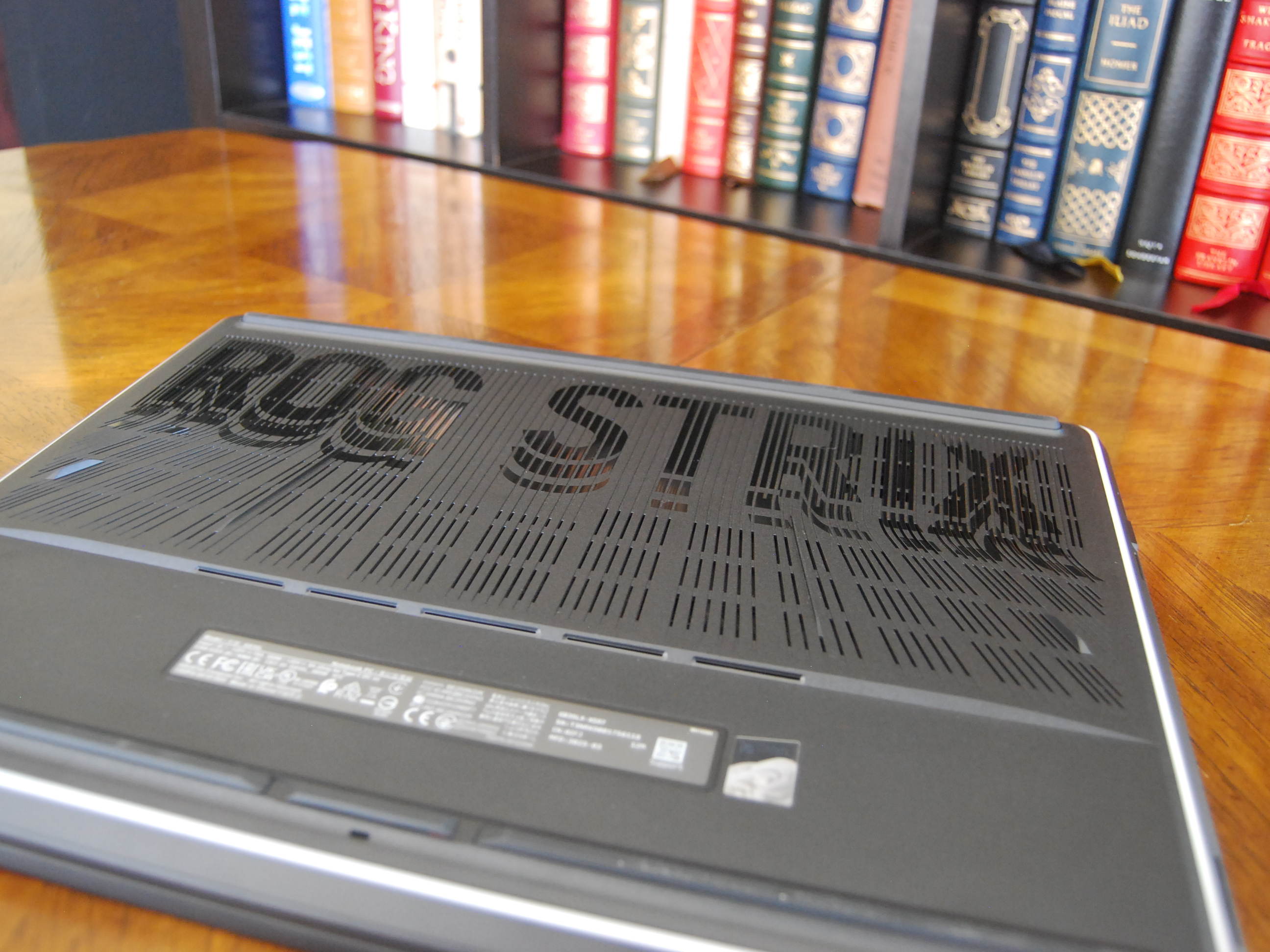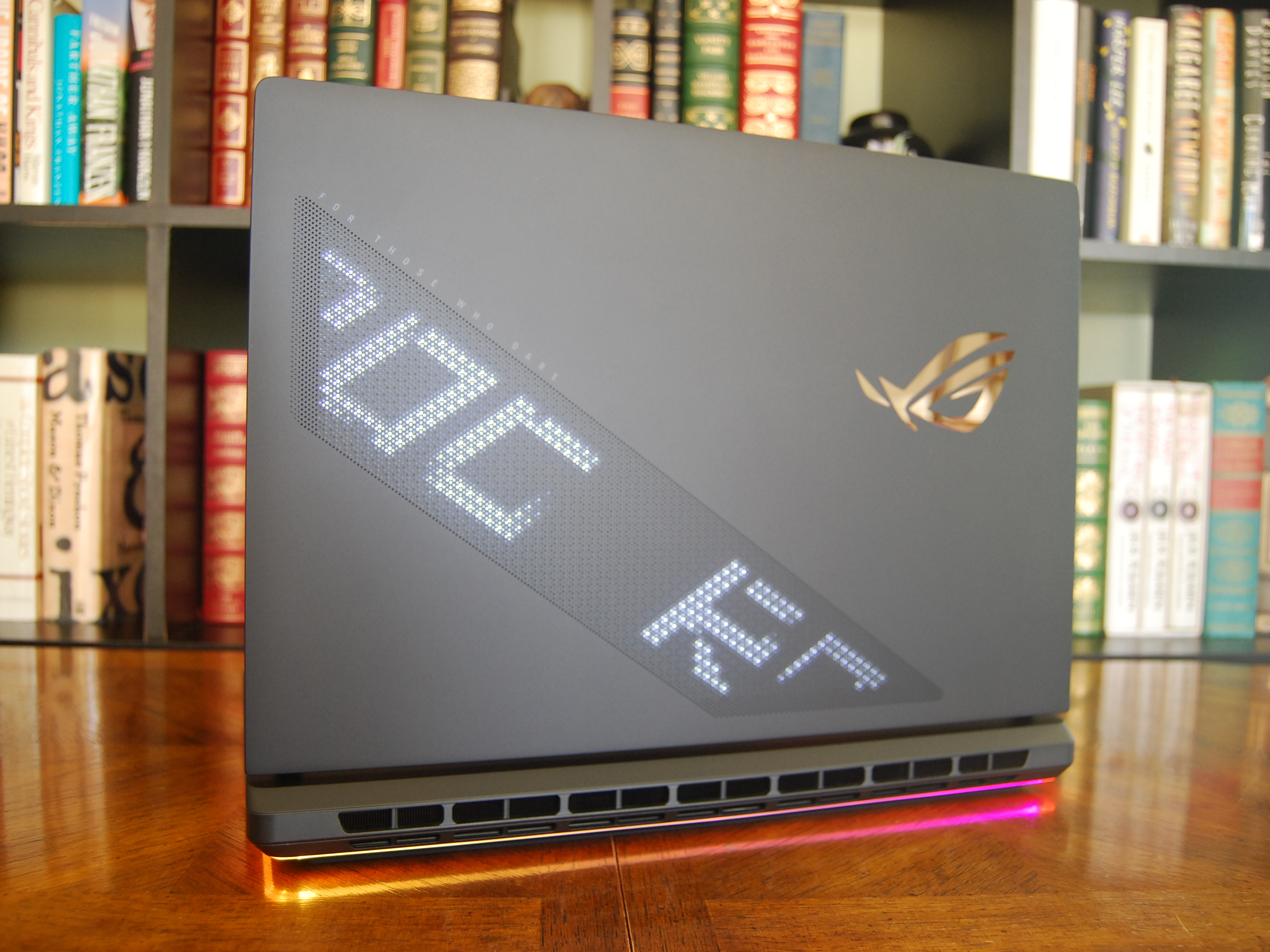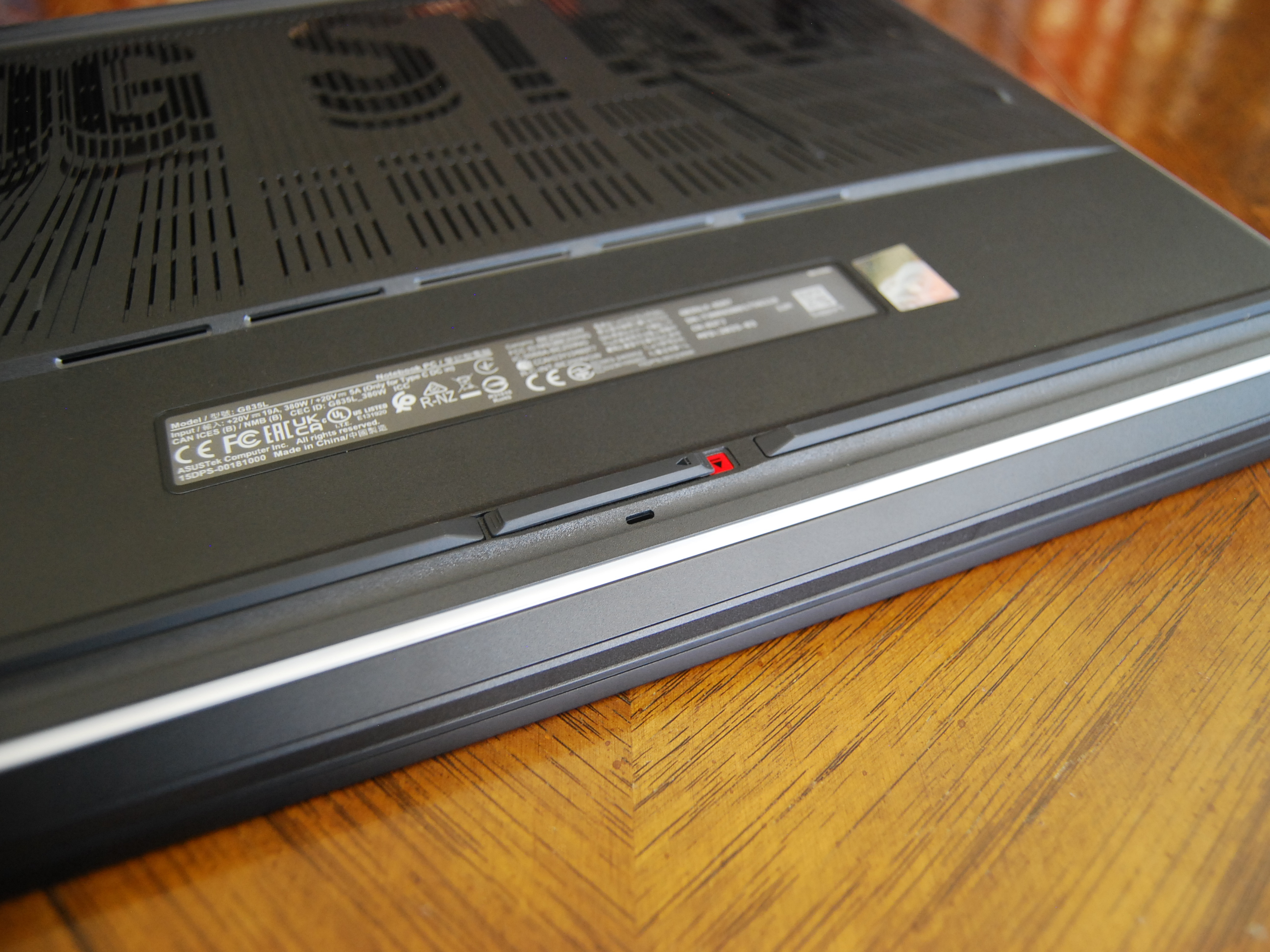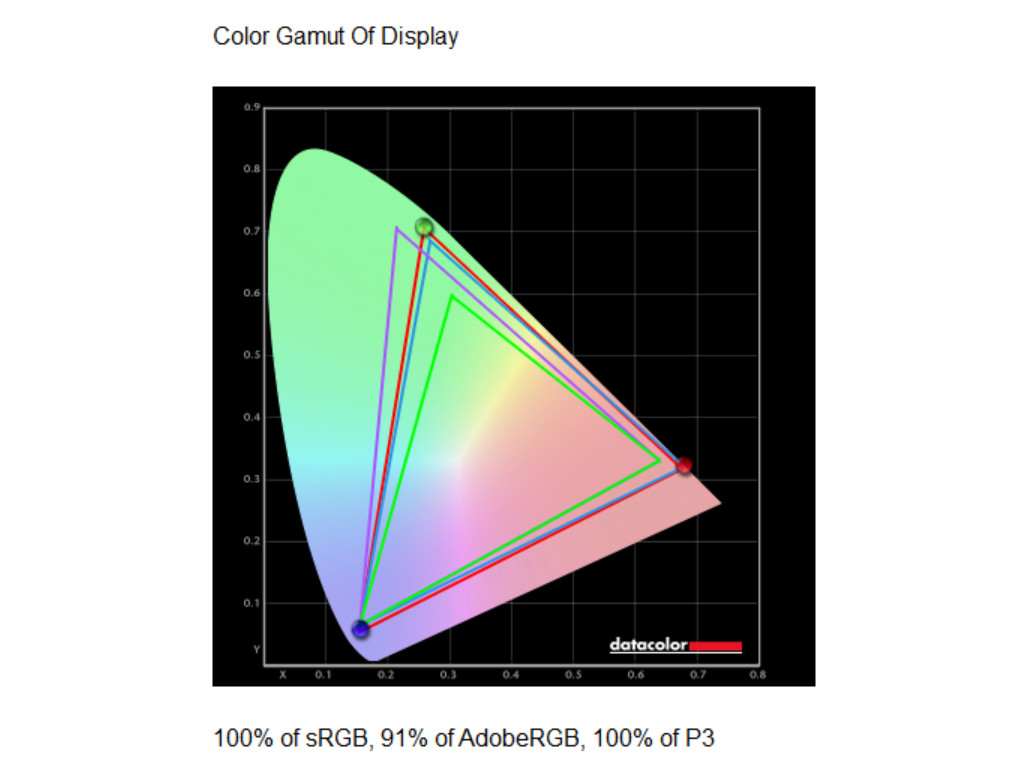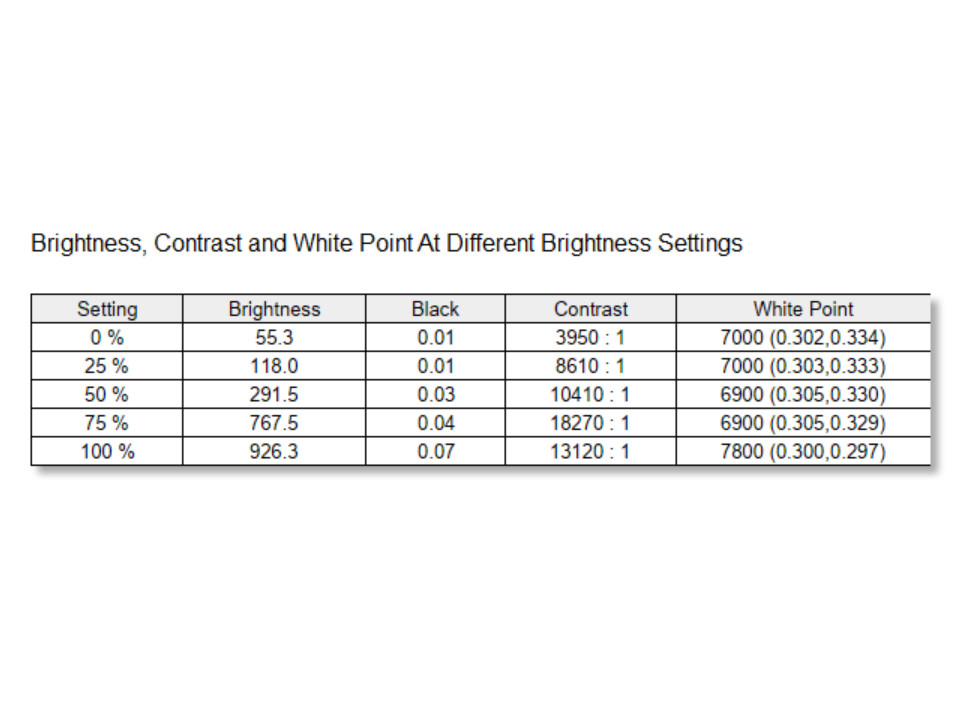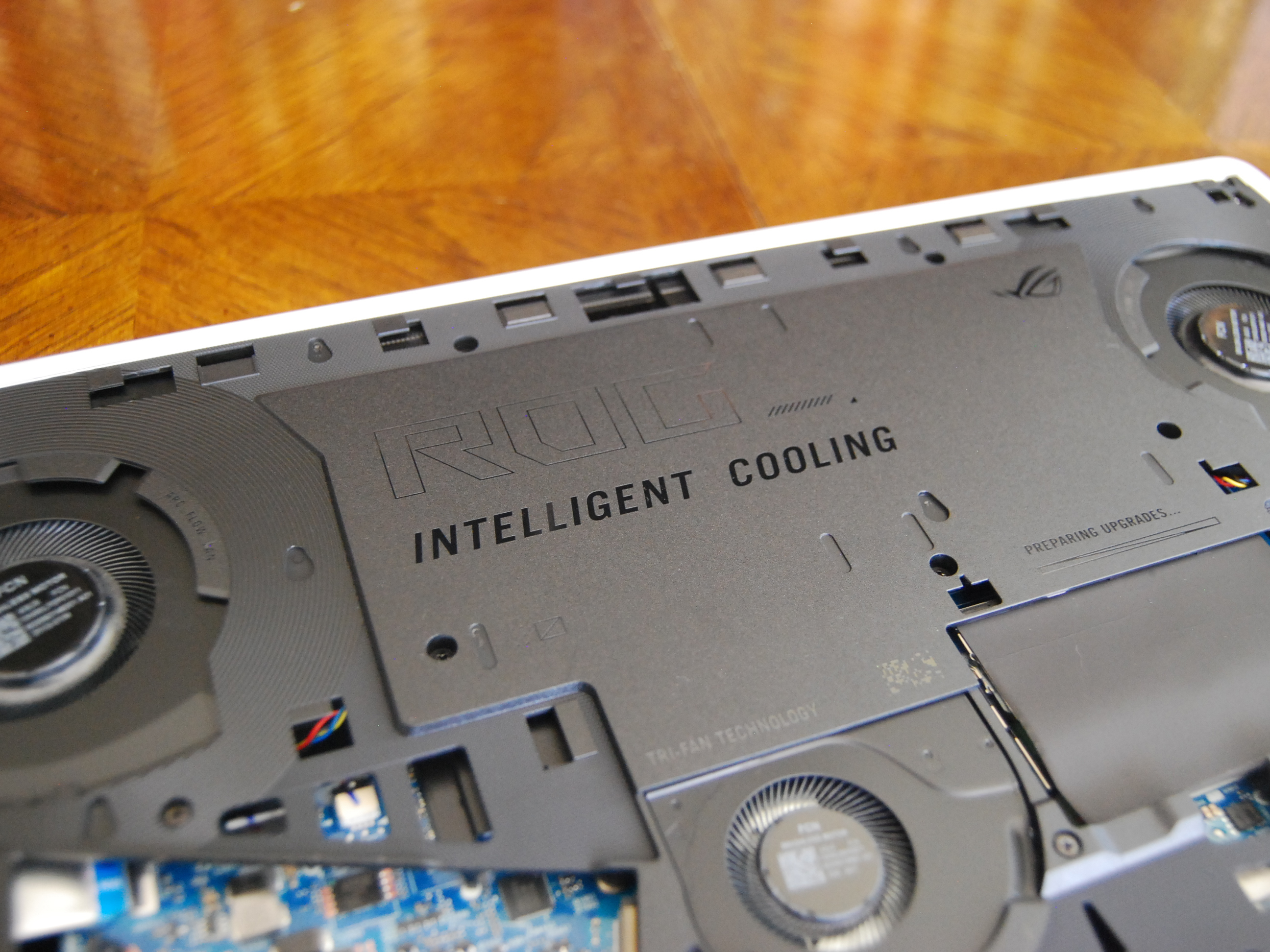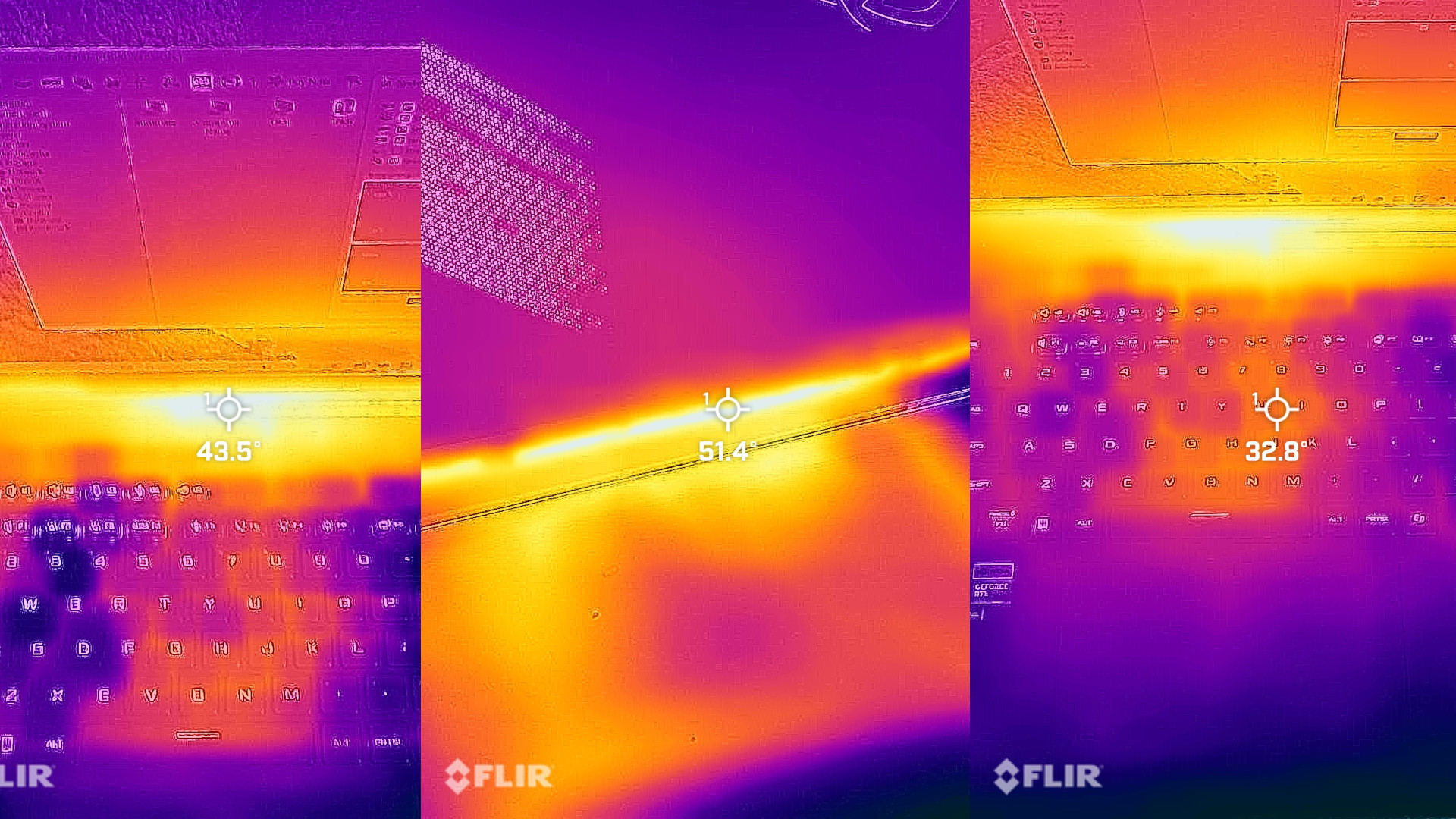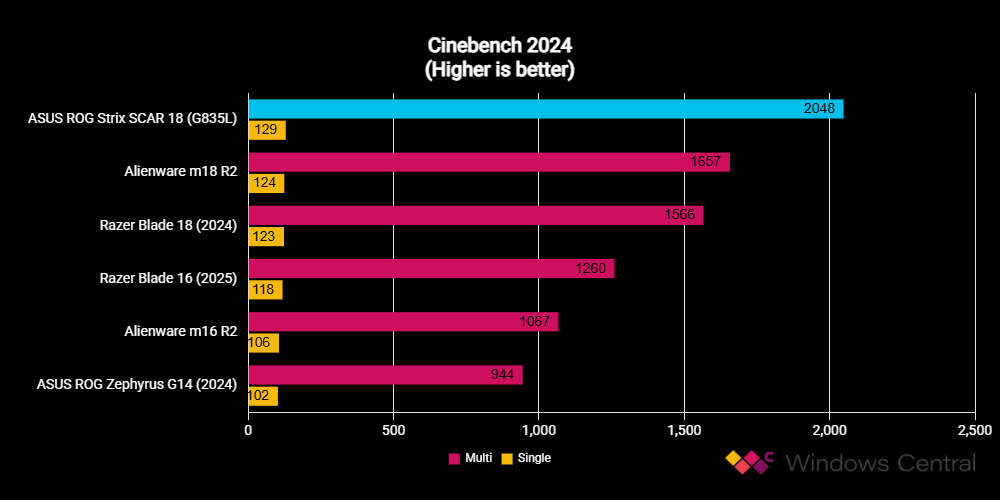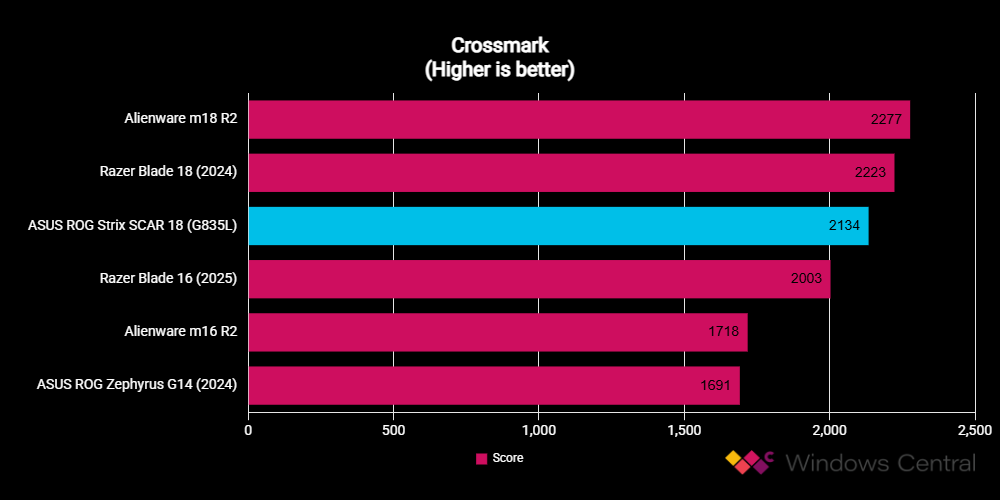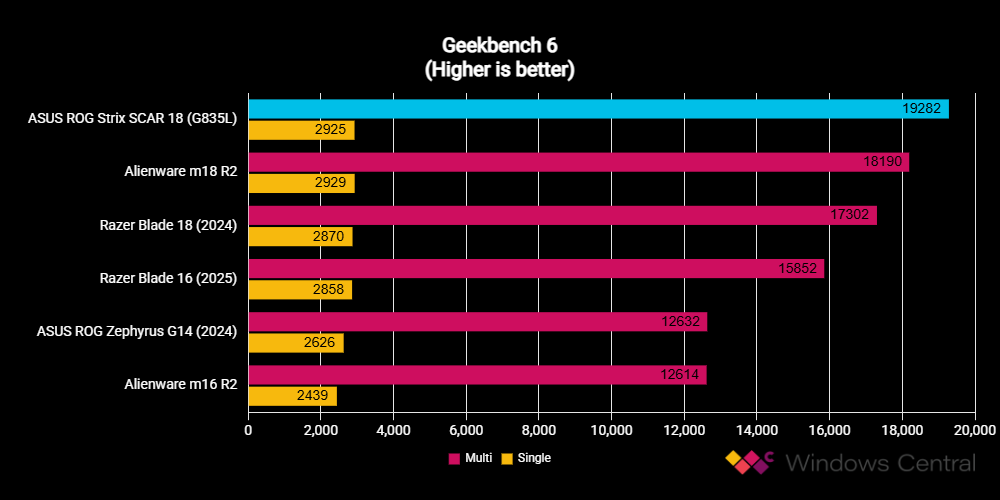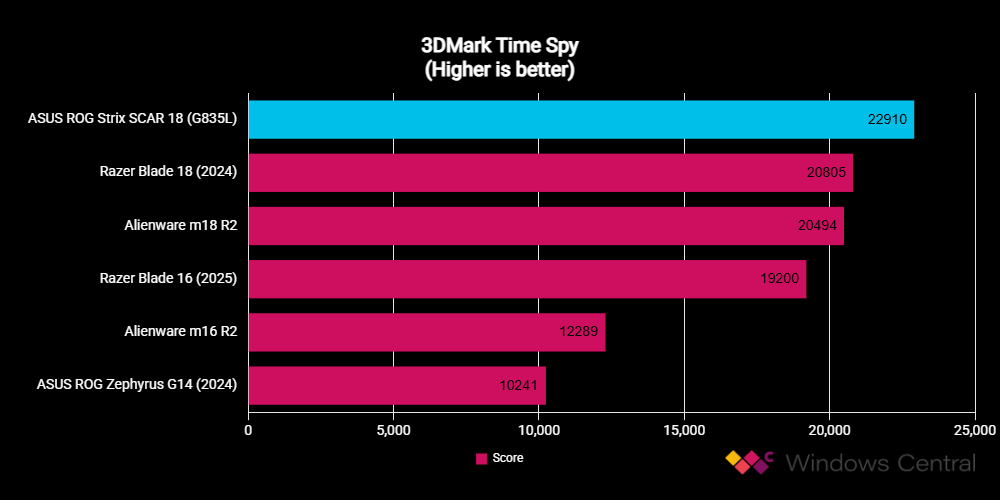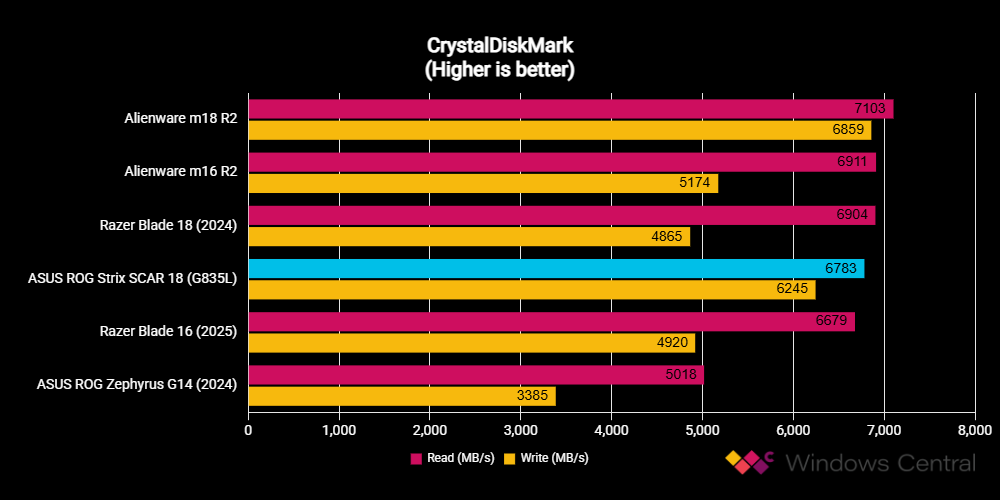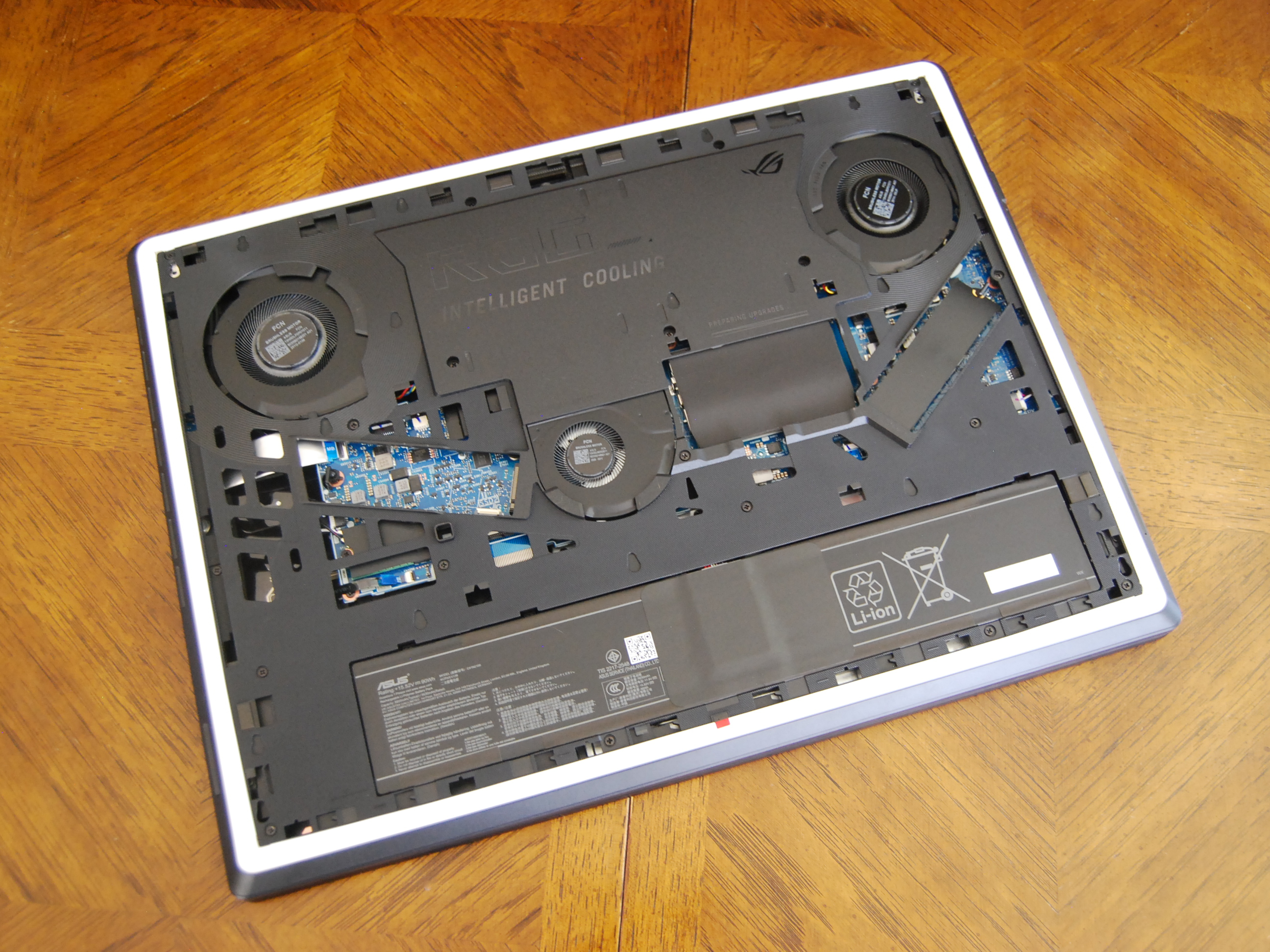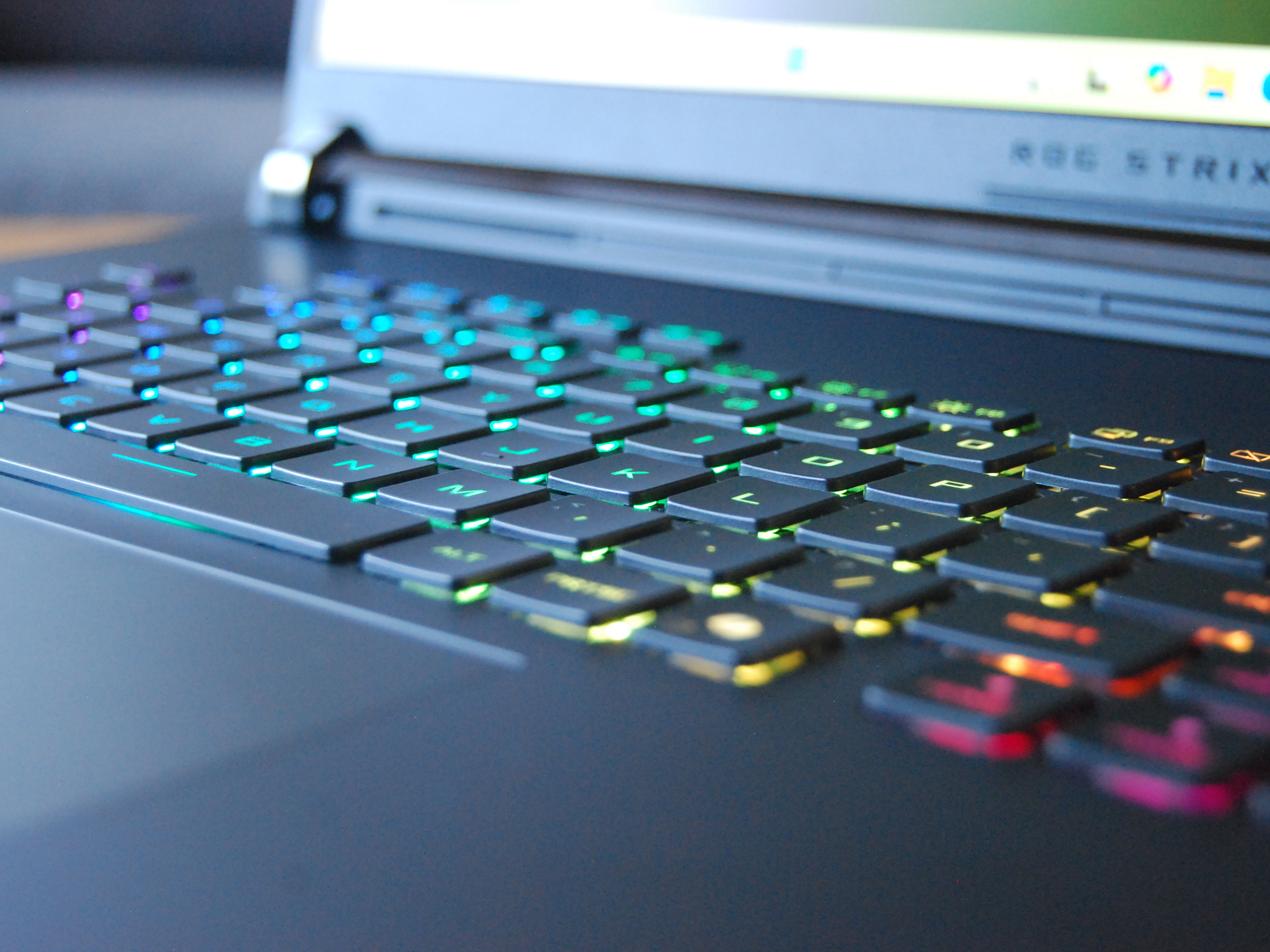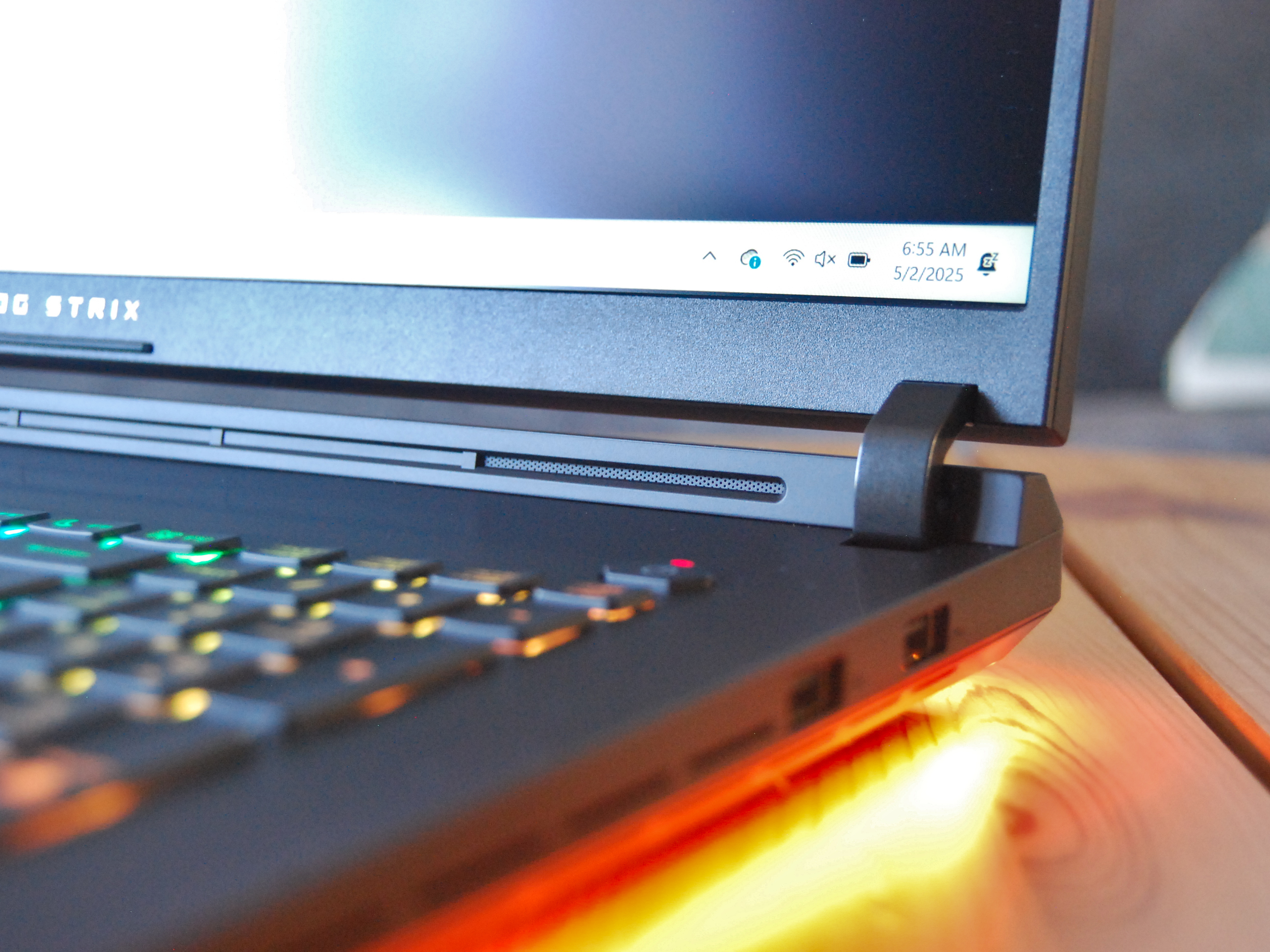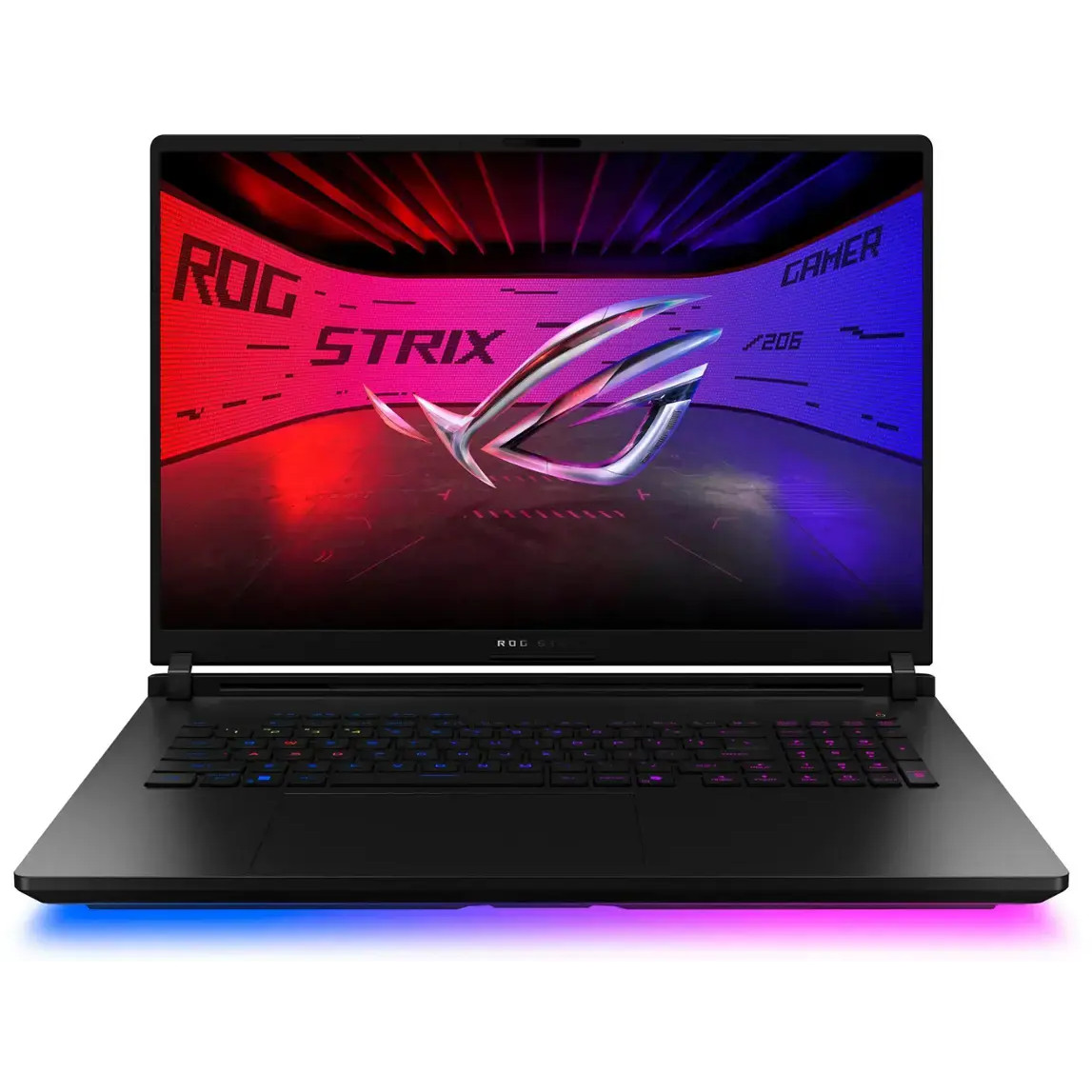Why you can trust Windows Central
Our expert reviewers spend hours testing and comparing products and services so you can choose the best for you. Find out more about how we test.
Gaming laptops featuring NVIDIA’s most powerful mobile GPU, the RTX 5090 Max-Q, remain fairly rare, but the ASUS ROG Strix SCAR 18 (G835L) is in my office for testing.
I went hands-on with the ROG Strix SCAR 18 as soon as it arrived, and I’ve now had a few weeks to put it through a plethora of tests and benchmarks.
Compared to the previous version from 2024, the new G853L model has been redesigned throughout to accommodate the monster GPU and to bring it more into a modern design.
And modern it is, with a revamped internal cooling system, AniMe Vision LED display on the outside of the lid, halo RGB lighting, and much more.
It’s still a massive slab of laptop — not much ASUS can do with an 18-inch chassis to slim it down — but it’s more streamlined than ever and, for the most part, has been a pleasure to use.
While I’m reviewing the laptop’s design and features, I’m also paying close attention to the NVIDIA RTX 5090 Laptop GPU inside to see how well it performs compared to its desktop counterpart.

Cale Hunt
I’ve been reviewing PCs at Windows Central since 2016, and thousands of hours of time spent testing gives me a clear idea of what you want in a gaming laptop.
This review was made possible thanks to a review unit from ASUS. It had no input on the content of this article, nor did it see the review prior to publishing.
ASUS ROG Strix SCAR 18 (G835L) review: Cheat sheet
- What is it? A premium 18-inch gaming laptop with an NVIDIA RTX 5090 Laptop GPU inside.
- Who is it for? PC gamers with deep pockets who want a potent NVIDIA GPU with access to all of DLSS 4’s tools and features.
- How much does it cost? Prices start at $2,700 for RTX 5070 Ti models, and climb to about $4,500 for a model similar to the one I’m reviewing here.
- What did I like? It’s hard to top the beautiful mini-LED display, and the laptop is set up to keep Intel and NVIDIA’s most powerful hardware cool.
- What did I not like? NVIDIA’s RTX 5090 Laptop GPU is not worth the asking price when the mobile RTX 5080 is so close behind.
ASUS ROG Strix SCAR 18 (G835L): Pricing, availability, and specs
ASUS’ store is currently the best place to check out listings for the ROG Strix SCAR 18, although availability is spotty.
The same holds true for third-party retailers like Best Buy and Newegg, where you’ll find listings for the most expensive configuration.
The ROG Strix SCAR 18 is available with an Intel Core Ultra 9 275HX CPU, QHD+ mini-LED display, and your choice of NVIDIA RTX 50-series laptop GPU, RAM, and SSD.
The most expensive version, with an RTX 5090 Laptop GPU, costs $4,500. However, models with an RTX 5070 Ti start at a more modest $2,700.
The $3,400 RTX 5080 config is the one I recommend to anyone who wants high-performance gaming; the RTX 5090 is too expensive for such a small power bump.
Following is a look at the specs available in the ASUS ROG Strix SCAR 18 (G835L). Note that my review unit has the RTX 5090 Laptop GPU, 32GB of DDR5 RAM, and a 2TB M.2 PCIe 4.0 NVMe SSD.
|
Spec |
ASUS ROG Strix SCAR 18 (G835L) |
|---|---|
|
CPU |
Intel Core Ultra 9 275HX |
|
Graphics |
NVIDIA RTX 5070 Ti, RTX 5080, RTX 5090 Laptop GPUs |
|
RAM |
16GB, 32GB, 64GB DDR5-5600MHz (upgradeable, 2 slots) |
|
Storage |
1TB, 2TB M.2 PCIe 4.0 NVMe (upgradeable, 2 slots) |
|
Display |
18 inches, 2560×1600 (QHD+), mini-LED, 240Hz, 3ms, anti-glare, Pantone validated, Dolby Vision, Nebula HDR, G-Sync, 1200 nits, VESA DisplayHDR 1000 |
|
NPU |
Intel AI Boost (13 TOPS) |
|
Ports |
2x Thunderbolt 5, 3x USB-A 3.2 (Gen 2), HDMI 2.1, 2.5G LAN, 3.5mm audio |
|
Connectivity |
Wi-Fi 7, Bluetooth 5.4 |
|
Battery |
90Wh |
|
Audio |
Quad speakers, Dolby Atmos, Smart Amp |
|
Camera |
1080p with IR |
|
Dimensions |
15.71 x 11.73 x 0.93-1.26 inches (39.9cm x 29.8cm x 2.35-3.2cm) |
|
Weight |
7.28 pounds (3.3kg) |
|
Warranty |
1 year |
The ROG Strix SCAR 18 (G835L) is all about providing the most power possible with its oversized chassis and robust cooling, and it doesn’t pretend to be a laptop made for value-conscious shoppers.
ASUS ROG Strix SCAR 18 (G835L) review: Design and build quality
The ROG Strix SCAR 18 isn’t like other 18-inch gaming laptops I’ve used in the past. Granted, it has been a few years, but it’s still surprising to see how thin these RTX 50-series models are in person.
Sure, it’s a laptop that weighs more than 7 pounds and measures more than an inch thick at the chunkiest point, but sizing is consistent across the PC.
Rounded edges, clean lines, and a forward-facing angle make it seem thinner than it is. The part I like least about the design is how quickly it picks up fingerprints and smudges.
The rear edge, where the laptop is thickest, is dominated by exhaust venting for the overhauled cooling system. This leaves the sides to hold all ports, thus making for messier cable management.
On the left are dual Thunderbolt 5, one USB-A 3.2 (Gen 2), HDMI 2.1, 3.5mm audio, 2.5G LAN, and the proprietary charging port.
The right side is home to two more USB-A 3.2 (Gen 2) ports, with the rest dedicated to some added venting (which does not blow any hot air onto your right hand). This is one of the few laptops with Thunderbolt 5 on the market so far, which is the best port you can hope for on a laptop.
Not only is it great for data, but it also supports DisplayPort for video out and NVIDIA G-Sync.
The lid is attached with two relatively small hinge arms. They have ample bite to keep the huge screen in place, and operation is smooth. They do, however, prevent the lid from tilting back further than about 130°.
I really like what ASUS has done with the lid panel, even if it’s completely unnecessary. It’s now home to an “AniMe Vision” display made up of 810 individual white LEDs.
They shine through 9,150+ pinholes drilled in the lid, and the design is entirely customizable. I mean entirely: you can upload your own images or GIFs, or create an image within the supporting software.
The bottom of the laptop is also ringed with a complete RGB halo. Like everything else, it’s customizable for color, pattern, and brightness.
I appreciate ASUS including a one-press “Stealth Mode” that turns off all lighting and effects; they can quickly become distracting when gaming or otherwise.
One part of the design I specifically called out in my hands-on preview is a quick-release latch for the bottom panel.
Just slide it to the side, push the panel back, and it lifts off without requiring any tools. As someone who has stripped more than a few screws when getting inside a laptop, this is a feature I want to see on more PCs.
The inside of the laptop is just as orderly and streamlined as the outside. You have quick access to the dual RAM and M.2 SSD slots for easy upgrades, but the rest of the hardware is protected beneath a secondary metal sheet held in by screws.
Considering you’ll hopefully never have to go much further than the RAM and SSD other than for cleaning, this is an ideal internal layout.
ASUS ROG Strix SCAR 18 (G835L) review: Display quality
The ROG Nebula HDR display in the Strix SCAR 18 is phenomenal. If all you need to know is that I have no complaints, you can skip to the next section.
It’s an 18-inch mini-LED panel, which ASUS says has more than 2,000 independent dimming zones. This allows for much more precise backlighting to better compete with OLED.
In-game or out, the picture is outstanding. Part of the magic falls on what ASUS calls an Ambient Contrast Ratio (ACR) layer. It’s designed to cut out glare and boost contrast, and it works quite well.
No matter what, the display remains clear and vivid.
At around 926 nits peak brightness without HDR enabled, you won’t have to worry about much glare. However, lowering the brightness to where it’s not searing your eyes doesn’t add a lot of reflections in a well-lit room. No matter what, the display remains clear and vivid.
The screen is Pantone Validated for those who aim to tackle creative and design work, and it hit 100% sRGB and 100% DCI-P3 color reproduction in my testing. AdobeRGB fell to 91%.
At a 240Hz refresh rate, there’s plenty of space to let the performance hardware hum, and NVIDIA G-Sync stops screen tearing. Dolby Vision certification is included to push quality even further.
ASUS ROG Strix SCAR 18 (G835L) review: Gaming performance and thermals
As the first RTX 5090 laptops arrived at review outlets, rumblings began surrounding the performance.
Notebookcheck was the first to publish its findings online, revealing an approximate 10% performance difference between the mobile RTX 5090 and its mobile 5080 sibling in the same Schenker XMG Neo 16 laptop.
This led me to explain why RTX 5090 laptops are a terrible value; the 5090 upcharge is generally anywhere from $800 to $1,000 (and beyond).
In the ROG Strix SCAR 18, the upcharge is a whopping $1,100, pushing the RTX 5080 config price from $3,400 to $4,500. Same CPU, same display, same memory, and storage.
Unfortunately, even the overhauled ROG Strix cooling system with three fans and a massive vapor chamber stretching to each side of the laptop doesn’t boost the RTX 5090 mobile GPU’s performance to a level where I could confidently recommend it.
I’m not placing the blame on ASUS; this is all on NVIDIA.
Viewing the RTX 5090 in a bubble keeps it looking impressive. Black Myth Wukong hit a 90 FPS average at 1600p with in-game Cinematic settings and ray tracing set to Very High.
Far Cry 6 managed a 112 FPS average at 1600p with in-game settings cranked all the way up and no DLSS enabled.
However, once the comparisons start, the RTX 5090’s small performance gains are exposed.
I’m not placing the blame on ASUS; this is all on NVIDIA.
My colleague Zachary Boddy received Lenovo’s 16-inch Legion Pro 7i (Gen 10) with an RTX 5080 mobile GPU for testing, allowing us to compare notes.
Both laptops use the same CPU and have the same amount of RAM. Both mobile GPUs have a 175W TGP.
Here’s how real-world gaming benchmarks played out when using each laptop’s full AC power profile. I added benchmarks from the Blade 16 (2025) with an RTX 5090 (160W) as well.
|
Game |
Settings |
ASUS ROG Strix SCAR 18 (G835L) RTX 5090 175W |
Lenovo Legion Pro 7i (Gen 10) RTX 5080 175W |
Razer Blade 16 (2025) RTX 5090 160W |
|---|---|---|---|---|
|
Cyberpunk 2077 |
Ray Tracing Ultra game preset, 1600p, DLSS SR (Auto), Reflex enabled, FG disabled |
80.5 FPS |
80 FPS |
69 FPS |
|
Cyberpunk 2077 |
Ray Tracing Overdrive, 1600p, DLSS ray reconstruction enabled, MFG 4x |
186 FPS |
179 FPS |
N/A |
|
Forza Horizon 5 |
Extreme game preset, 1600p, DLSS disabled, best power profile |
165 FPS |
158 FPS |
144 FPS |
|
Forza Horizon 5 |
Extreme game preset, 1600p, DLSS enabled, best power profile |
258 FPS |
233 FPS |
211 FPS |
|
Gears 5 |
Ultra game preset, 1600p |
134.9 FPS |
134 FPS |
127 FPS |
NVIDIA recommends testing its RTX 50-series laptops on the Balanced Windows power profile — the theory is that the CPU and GPU can better balance themselves to avoid throttling — so I re-ran the tests, bypassing ASUS’ power settings.
Gears 5 took the smallest hit, dropping from 134.9 FPS to 130.3 FPS.
Forza Horizon 5 dropped from 165 FPS to 150 FPS with DLSS disabled. It dropped from 248 FPS to 233 FPS with DLSS enabled.
Cyberpunk 2077 dropped from 80.5 FPS to 76.5 FPS with Frame Gen disabled. It dropped from 186 FPS to 173.2 FPS with Frame Gen enabled.
In the case of the ROG Strix SCAR 18, which could have the most robust cooling system of any RTX 50-series laptop based on its sheer size, NVIDIA’s Balanced Windows power profile recommendation isn’t necessary … at least as long as you don’t care about fan noise.
I used Cyberpunk 2077 as a metric, as it’s the game that best pushes the PC to its limits. My trusty decibel meter measured 53 dBa using the Windows Balanced override and again at 58 dBa with the ASUS Ultra profile.
Those 5 decibels do make a difference — it’s akin to someone talking softly in an otherwise quiet office — but I’m not sure it’s worth shaving off around 15 FPS.
What about heat? I ran a 15-minute system stress test with the ASUS Ultra power profile enabled to push the laptop beyond what you’d normally see when gaming.
The exterior hotspot over the GPU reached about 43.5°C, but it’s out of the way of the keyboard. The hottest spot on the keyboard, near the center, reached 30°C. The WASD keys remain cool.
The back of the laptop is where heat is expelled, and it understandably reached about 52°C. You’ll definitely want to keep the laptop’s rear venting clear, but ASUS engineered the laptop to keep any hot air from blowing out the sides.
Gaming performance from the mobile RTX 5090, at least compared to the mobile RTX 5080, isn’t impressive.
On the other hand, the Intel Core Ultra 9 275HX “Arrow Lake” CPU put up impressive numbers in synthetic benchmarks.
The usual high-end NVIDIA features are here, including a MUX switch and Advanced Optimus for improved efficiency.
Bottom line? This is a laptop that can deliver the best possible performance from its included hardware.
Unfortunately, the RTX 5090 Laptop GPU doesn’t make a strong case for itself when compared against the mobile RTX 5080.
If you’re interested in this laptop, I strongly recommend saving yourself $1,000+ for similar performance from the 5080.
ASUS ROG Strix SCAR 18 (G835L) review: Battery life
NVIDIA introduced a new version of Battery Boost on its RTX 50-series laptops. It’s designed to intelligently lower frame rates when viewing maps, menus, and other low-action scenes.
Unfortunately, when attempting to play games with Battery Boost enabled, I couldn’t actually get into any games before the system froze up, requiring a restart.
As with any laptop with this much power, you’ll want to stick close to an AC outlet when gaming.
I tried using a couple of versions of NVIDIA’s drivers, but to no avail. Add this to the list of broken NVIDIA features caused by shaky drivers.
Running the same games with the same drivers and Battery Boost disabled does not present the same crashing/freezing issues.
Using Forza Horizon 5 as an example, I ran an optimized battery gaming test: DLSS Super Resolution set to Balanced, Frame Gen on, Low Latency on, DLAA off, and High in-game settings. The power profile was set to Windows Balanced.
The 90Wh battery managed about 50 minutes of playtime with these settings. That’s not awful considering the level of performance hardware inside, but it’s certainly not great.
As with any laptop with this much power, you’ll want to stick close to an AC outlet when gaming.
What about productivity work? I set the laptop to use the Windows Balanced power plan with 50% screen brightness, a 60Hz screen refresh rate, and NVIDIA Optimus.
In these circumstances, I saw about three to four hours of battery life before needing to plug back in.
ASUS ROG Strix SCAR 18 (G835L) review: Keyboard and touchpad
The Strix SCAR 18’s keyboard is set seamlessly into the deck, which definitely contributes to the streamlined appearance.
There’s more than enough room on the chassis to fit a full board with a number pad, and ASUS has gone one step further by adding five additional macro keys along the top.
They’re set up standard as hotkeys for speaker volume, mic mute, performance profile, and ASUS Armoury Crate quick-launch, but you can configure each one to your liking.
ASUS says this is an “esports-grade” keyboard; its switches, while not mechanical, have a 20-million-press durability rating, and the board includes n-key rollover to not interfere with your more frenetic games.
Each key can be customized individually for RGB lighting, and it can all be synced up with the rest of the laptop’s RGB effects.
Key presses are firm, there’s lots of travel, and I’ve had no issues using the keyboard in the tested games. The same goes for general productivity work, as the board remained comfy after thousands of words.
There’s nothing special about the touchpad. It’s large, it has moving parts instead of haptic feedback, and it does a good job of pointing.
ASUS ROG Strix SCAR 18 (G835L) review: Other hardware
I was expecting a laptop this expensive to have some sort of above-average camera; alas, that’s not exactly the case.
ASUS went with a 1080p webcam in the top bezel, which is on the low end of resolution in 2025. Nevertheless, color and contrast are solid. I just wish it were a bit more crisp.
The good news is that the camera includes an IR sensor for Windows Hello, something that’s not common on gaming PCs. While you get some added security through facial recognition, the lack of a privacy shutter will irk some.
The audio setup, on the other hand, is outstanding.
Testing stock sound out of the box, the laptop does a great job with highs and lows, whether you’re listening to music or playing games.
There are four speakers here: two live on either side of the laptop, embedded into the wedge-shaped base to prevent muffling when the PC is on a desk.
Two other speakers are located between the display and keyboard on a raised section. They face directly out towards the user, so it always feels like you’re in the middle of the sound when seated in front of the PC.
Sounds only got better when I started messing around with Dolby Atmos controls.
ASUS ROG Strix SCAR 18 (G835L) review: Also consider
ASUS ROG Strix SCAR 18 (G835L) review: Score card
|
Attribute |
Rating & notes |
|---|---|
|
Value |
2.5/5 — The RTX 5090 is a terrible value, but that’s not ASUS’ fault. RTX 5080 models are much more reasonable but still pricey. |
|
Design |
4/5 — Beautifully streamlined, AniMe Vision panel, lots of ports. |
|
Display |
5/5 — Mini-LED display is incredible for gaming and general use. |
|
Performance |
5/5 — Ignoring the 5090’s poor performance, the laptop has awesome cooling potential for maximum GPU power and a ripping CPU. |
|
Battery |
3/5 — I was able to get about 50 minutes of playtime with nerfed settings. General battery life when not gaming hit around XX hours. |
|
Keyboard |
4/5 — I have no issues with the keyboard and touchpad here, though haptics would be nice in something so expensive. |
|
Other hardware |
4/5 — The 1080p camera isn’t particularly impressive, but the IR sensor and outstanding audio make up for it. |
|
Overall |
⭐⭐⭐⭐ — An high-end gaming laptop with lots of premium features and stellar cooling abilities can’t make the RTX 5090 look like it’s worth buying. |
ASUS ROG Strix SCAR 18 (G835L) review: My final thoughts
✅ You should buy this if …
- You’re a PC gamer who doesn’t mind sticking close to an AC outlet.
- You want premium features like halo RGB lighting, AniMe Vision display, full RGB keyboard, and stellar audio.
- You want a gorgeous 240Hz mini-LED display with impressive color and contrast.
❌ You should not buy this if …
- You can only find RTX 5090 models for sale.
- You prefer an AMD CPU paired with the NVIDIA RTX 50-series GPUs.
- You want a smaller gaming laptop that’s easier to carry.
I’ve thoroughly enjoyed my time with the ROG Strix SCAR 18 (G835L), and I don’t want to give up the mini-LED display. Going back to my standard IPS monitor for gaming, the difference is huge.
The laptop is a bit big for my liking — I prefer a more mobile chassis to pair with my desktop gaming PC — but for others looking for a desktop replacement while shopping for the best gaming laptops, ASUS has done a great job slimming it down compared to previous generations.
Part of that redesign includes a new vapor chamber and three fans. It’s enough to keep the system relatively cool when under full load, and ASUS power balancing keeps hardware from throttling.
The Intel Core Ultra 9 275HX CPU provides a ton of power for gaming, but the RTX 5090 is a different story. It just doesn’t deliver enough of a performance difference compared to the RTX 5080 to warrant an $1,100 upcharge.
I strongly recommend saving yourself that money and opting for an RTX 5080 or RTX 5070 Ti model instead. Prices start at about $2,699, which is a lot more reasonable than the $4,500 asking price for the 5090 model.


